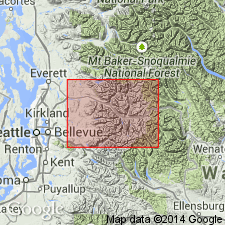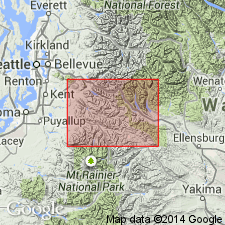
- Usage in publication:
-
- Tiger Mountain Formation*
- Modifications:
-
- Named
- Biostratigraphic dating
- Dominant lithology:
-
- Sandstone
- Siltstone
- Coal
- AAPG geologic province:
-
- Puget Sound province
Summary:
Named as member of Puget Group from exposures on Tiger Mountain about 7 mi southeast of Issaquah, King Co, WA. Type area includes south slope of Tiger Mountain and north slope of adjacent Taylor Mountain in SW/4 sec.9, sec.16, S/2 sec.17, N/2 secs.20-21 T23N R7E, King Co, WA. Formation is mainly nonmarine arkosic sandstone (3000 ft thick). Lower 1100 ft is medium-grained, cross-bedded sandstone and siltstone which is transitional with rocks of underlying marine Raging River Formation (new). Locally lower unit includes bed of commercial(?) coal in its upper part. Upper 900 ft of formation is mainly sandstone, in two members that interfinger with two members of overlying Tukwila Formation of Puget Group through a stratigraphic interval of 1725 ft. Fossil leaves identified by J.A. Wolfe indicate middle(?) and late Eocene age.
Source: GNU records (USGS DDS-6; Menlo GNULEX).

- Usage in publication:
-
- Tiger Mountain Formation*
- Modifications:
-
- Age modified
- Geochronologic dating
- AAPG geologic province:
-
- Puget Sound province
Summary:
Age is reported [in text] as late early to middle Eocene on basis of plagioclase K-Ar and (or) apatite fission-track radiometric ages from Tiger Mountain area. [Note that fig.3 shows Tiger Mountain Formation as middle Eocene age].
Source: GNU records (USGS DDS-6; Menlo GNULEX).

- Usage in publication:
-
- Tiger Mountain Formation*
Summary:
Not compiled to date. Publication available online: http://ngmdb.usgs.gov/Prodesc/proddesc_10042.htm
Tiger Mountain Formation of Puget Group. Age is middle and early Eocene.
Source: Publication.

- Usage in publication:
-
- Tiger Mountain Formation*
- Modifications:
-
- Age modified
- Areal extent
- AAPG geologic province:
-
- Puget Sound province
Summary:
Tiger Mountain Formation is geographically extended into the report area. Age is everywhere revised from late early and middle Eocene to: middle Eocene (based on radiometric dating).
Source: GNU records (USGS DDS-6; Menlo GNULEX).
For more information, please contact Nancy Stamm, Geologic Names Committee Secretary.
Asterisk (*) indicates published by U.S. Geological Survey authors.
"No current usage" (†) implies that a name has been abandoned or has fallen into disuse. Former usage and, if known, replacement name given in parentheses ( ).
Slash (/) indicates name conflicts with nomenclatural guidelines (CSN, 1933; ACSN, 1961, 1970; NACSN, 1983, 2005, 2021). May be explained within brackets ([ ]).

